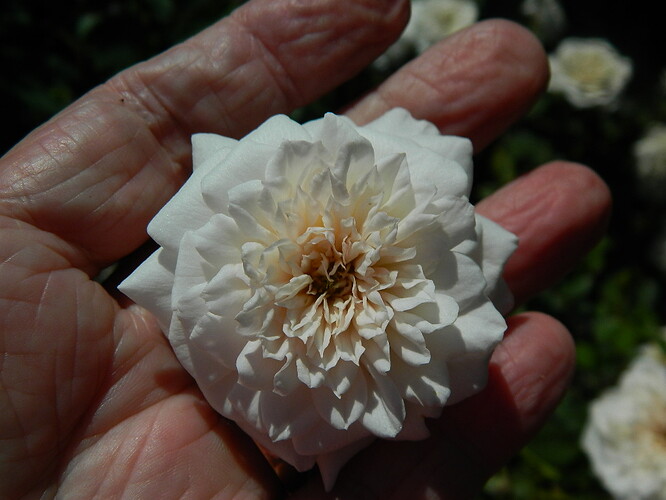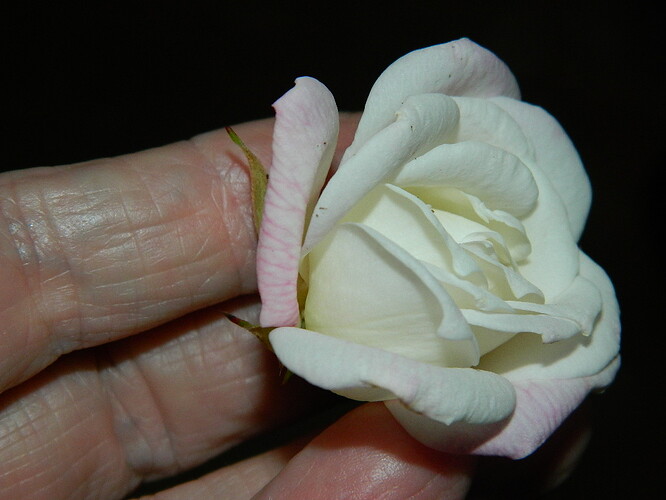If you were to go back and select only one OGR of any category to work with as a beginning rose gardener interested in hobby hybridizing, which would you recommend, and for what reasons?
Even before that question, I’d have to recommend selecting a class which is suited to your climate. It won’t be of any benefit to you for anyone to suggest roses which aren’t sufficiently cold hardy or disease resistant in your climate. So, where will they be grown and used for breeding? That answer will help provide you with suitable suggestions.
I live in East TN on the border of zones 6 and 7. The main issue around here seems to be blackspot, as well as Japanese beetle infestations in the midsummer.
What does OGR stand for?
Sorry I am bad at guessing acronyms.
“Old Garden Rose”, types generally predating the first “Hybrid Tea”.
I think OGRs are really cool! I live in charleston south carolina, so take this as you will. Gallicas hate it here, they crap out easy, even if they are supposed to be super disease resistant. The portlands and bourbons i have here are also sad looking. I only have one hybrid perpetual and it does ok, but its still not great. My autumn damask is doing incredibly well, very disease resistant and is almost too big of a beast to handle. I havent had much success with breeding autumn damask though, it flowers as long as i dont prune it. You will probably have the most success with damasks if your climate is similar to mine. You might also have success with some hybrid perpetuals with lots of damask or china in the background, but honestly i think hybrid perpetuals are a gamble.
I am currently working on some OGR x woodsii hybrids to make some more suitable for the states and increase their range. My woodsii is surprisingly one of the best roses i have in my south carolina garden, though it isnt spotless. I have some tuscany superb x woodsii seeds that will hopefully produce some great seedlings. I really wanted to cross my gallica officionalis with my woodsii this year but none of the pollen took.
Thanks, I wouldn’t have guessed. I don’t have any Old Garden Roses. I assume that ultra-modern roses have improved massively, and probably have the best bits of old fashioned roses in their genes already? I will watch this thread with interest, I am a beginning rose gardener interested in hobby hybridising. I don’t need a rose to be cold-resistant as my climate is very mild and the winters barely touch zero degrees Celsius (32 degrees Fahrenheit), but my criteria are fungus resistant and with a good scent, and preferably single or semi-double but that last isn’t so important if the stems are strong enough to support the flowers and if pollinators like them. I like a good flower to bulk ratio, and don’t have much space, so Rosa rugosa is a no, though I would use its pollen to introduce disease resistance, toughness, scent and gorgeous flowers. Rosa rugosa spreads like crazy with suckers and doesn’t produce enough flowers for the space it takes up; I need something more compact, be it climber, bush, or miniature.
and probably have the best bits of old fashioned roses in their genes already?
it’s kind of subjective, there’s a lot of traits in OGRs that aren’t in moderns, those traits aren’t necessarily bad or positive, just different. The big breeders/distributors will follow sales or where they believe they can shift the market towards sales (eg Flower Carpets kind of “created” a niche through marketing, they likely wouldn’t have sold well without that shift) because if money isn’t coming in there’s not a lot of reason to develop something further.
Add in 100+ years of consumers being largely travelled down the HT/Flori road and what the average consumer see’s as a rose also shifts expectations. Like show randoms some Hybrid Musks and a bunch of them won’t even recognise them as roses, flowers small, informal in huge clusters that almost completely cover the plant…so there’s also things like that at play in what sells and in what gets developed. Like is it “best” for flowers to only develop at the ends of a cane or along the whole cane? End of the cane works better for cutting and shows but that’s specific situations. Just different.
In what country to you live, @julie845931? It is unkind to make suggestions or show you possible ideas to follow if you can’t obtain any of the possible parents which resulted in the suggestions. I raised an interesting smaller climber from the fertile triploid mini Apricot Twist X the old Noisette, Lamarque. It flowers continuously and is healthy where I am. Not much scent, but that’s something which might be able to be mined from further attempts between those two parents.
A sibling which isn’t as nice a plant produces these flowers.
Smaller, OGR seeming climbers which flower continuously and healthy where they were raised. How they may do elsewhere, I have no idea, but for mini X OGR, they’re interesting.
Is it all gallica’s or just the more common ones?
I personally haven’t explored them too heavily because was living in an area that didn’t even have enough chill hours for bearded iris so straight Gallica’s would likely never flower. But some like La Belle Sultane/Violacea or Jenny Duval generally seem to be more consistently rated health wise were a lot of others is mixed reviews.
I have a number of La Belle Sultane derivatives (via a Crested Moss x La Belle Sultane rose named Helga Brauer) and the health of those is high (and unlikely coming from Crested Moss given that’s kind of spotty here…all the centifolia’s I’ve had and seen in person get spotty which is a bit disappointing).
Have picked up a couple straight gallica this season (as I moved 8hrs south, southern hemisphere so south = colder) so will see what they do (probably still not enough chill though…but curiosity)
I can’t speak from experience as my climate is totally different from yours, but doing an advanced search on HMF for OGR category roses with the criteria “good/very good blackspot resistance” led me to the gallica President de Sèze (Hebert 1828). It only has one descendant as a seed parent so I have no idea how difficult hybridizing with it would be.
Also in the search results was Polyantha Grandiflora (Bernaix, 1886), which appears to be fertile both ways.
That search also brought up a number of Paul Barden’s creations (Belle-Maiden, Carol Whitten, Lavender Licorice, Rook and Umbra), which could be great options if you have access to them.
I don’t grow any of these but perhaps others here will have more useful answers to your question.
Umbra is a beautiful, healthy rose, but it didn’t set seed for me this season on many attempts. I asked Paul Barden and he had the same experience. I will keep trying though because it’s my most vigorous rose.
It’s a difficult question to answer, and I sincerely hope that you wouldn’t be limited to just one OGR for a variety of reasons. If I were truly backed into such a corner and had to choose, I would probably go back one step before Kim and pick ‘Blush Noisette’. For a beginning rose gardener and hobby hybridizer in your area, it would provide a good garden plant–fragrant, hardy, everblooming, tough, and reasonably healthy (it can climb but is more often grown as a shrub, so it can fit into most gardens)–that is also fertile both ways and will easily produce everblooming seedlings with juvenile flowering. It is the ancestor of virtually all subsequent Noisettes and tea-Noisettes.
Stefan
You might find the first several seedlings in this blog post interesting. Instead of going back to something “historic”, I used historic types to create the “OGR” I used. Nessie is [(R. Brunonii X R. Gigantea) X Mlle Cecile Brunner]. This I crossed with the Viraraghavan “Tea”, Faith Whittlesey, as well as Mlle de Sombreuil, my climber, Annie Laurie McDowell; another seedling resulting from Sally Holmes and Secret Garden Musk Climber, Sweet Riley. The more “out there” seedlings resulted from Nessie crossed with Micro Mini, Tom Thumb. Feel free to browse. Pushing the Rose Envelope: Seedlings occupying my time during the pandemic
I grew up in the SE and for that reason, my biases would lean towards teas, noisettes, chinas and hybrid musks, most of which would not be cold hardy in the northern half of the US. Reason is, in my climate, a non-recurrant rose is a waste of a nearly 300 day growing season.
But I don’t really bother. I do wish for the occasional old rose to hit with something ridiculously modern, but for the most part, I feel they have been heavily mined for their best traits already in their progeny, and they do have shortcomings to overcome compared to some modern hybrids.
Species are another matter to me, ironically. I do feel there could be much untapped potential in underutilized species roses.
…and Kim has done some cool stuff with some older cultivars. Of course he lives in CA which is rose utopia so mileage may vary. ![]()
(I have California climate envy.)
Fascinating thread. I have been looking at a lot of Old Garden Roses. I have a book, “The Quest for the Rose”, by Phillips and Rix, with a chart in the back showing roughly how all these OGR’s are related to each other. The OP asked a great question, which one would you choose.
I have a small climber that I like called “Nice Day” by Christopher Warner, who seems to have been one of the pioneers of miniature climbers.
I think breeding something like your miniature climber is beyond my ability for a long time yet.
I have been reading a lot about the history of the top rose breeders, and Ralph Moore seems to have a special magic, he created some of the most beautiful roses.
I will look more at Noisettes and Lamarque (an appropriately named rose for somebody curious about rose epigenetics).
I am curious about the rose King Louis XIV, which is a China. Very dark red, almost black, with good scent, I read unusual for a China. I read that it is a compact little thing, repeat flowering, and the only issue seems to be that the nurseries describe its disease resistance as “moderate”, which sounds a bit euphemistic. I am deeply drawn to its colour, but mildew would drive me crazy.
I already have a modern rose with quite deep red flowers, which I absolutely love for its colour. It is a miniature called “Peter Pan”, very little scent and does get a bit of blackspot but no mildew yet. It isn’t as strong as I would ideally like, it is just those gorgeous tiny perfectly formed deep red flowers that I forgive its less than perfect qualities.
So yes, my reasons overwhelming the gorgeous deep red colour. And I would expect a lot of work against at least blackspot and if really unlucky mildew. The latter is what puts me off OGR’s, and I heard an expert describe one old fashioned rose as Charles de Mildew.
I am not an expert at all, and don’t have King Louis XIV but if I was selecting only one OGR, that might be it, overwhelmingly for its gorgeous colour, fragrance, and compactness.
Actually, Julie, it probably isn’t. You may succeed by crossing an OGR with Nice Day, or using a Noisette with any suitable mini. It isn’t really difficult and often is accidental.





